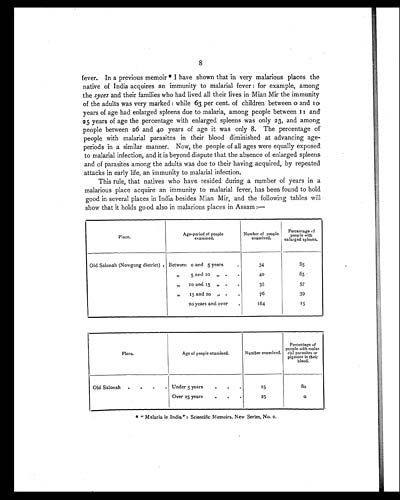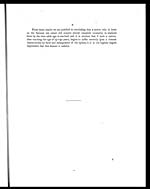Medicine - Institutions > Army health reports and medical documents > Scientific memoirs by officers of the Medical and Sanitary Departments of the Government of India > Number 19 - On kala azar, malaria and malarial cachexia > On kala azar, malaria and malarial cachexia
(16) Page 8
Download files
Individual page:
Thumbnail gallery: Grid view | List view

8
fever. In a previous memoir* I have shown that in very malarious places the
native of India acquires an immunity to malarial fever: for example, among
the syces and their families who had lived all their lives in Mian Mir the immunity
of the adults was very marked: while 63 per cent. of children between 0 and 10
years of age had enlarged spleens due to malaria, among people between 11 and
25 years of age the percentage with enlarged spleens was only 23, and among
people between 26 and 40 years of age it was only 8. The percentage of
people with malarial parasites in their blood diminished at advancing age-
periods in a similar manner. Now, the people of all ages were equally exposed
to malarial infection, and it is beyond dispute that the absence of enlarged spleens.
and of parasites among the adults was due to their having acquired, by repeated
attacks in early life, an immunity to malarial infection.
This rule, that natives who have resided during a number of years in a
malarious place acquire an immunity to malarial fever, has been found to hold
good in several places in India besides Mian Mir, and the following tables will
show that it holds good also in malarious places in Assam :—
| Place. | Age-period of people examined. |
Number of people examined. |
Percentage of people with enlarged spleens |
| Old Salonah (Nowgong district) . | Between 0 and 5 years. | 34 | 85 |
| " 5 and 10 " | 40 | 65 | |
| " 10 and 15 " | 35 | 57 | |
| " 15 and 20 " | 76 | 39 | |
| 20 years and over | 164 | 15 |
| Place. | Age of people examined. | Number examined. | Percentage of people with mala rial parasites or pigment in their blood. |
| Old Salonah | Under 5 years | 25 | 80 |
| Over 25 years | 25 | 0 |
*" Malaria in India": Scientific Memoirs. New Series, No. 2.
Set display mode to: Large image | Zoom image | Transcription
Images and transcriptions on this page, including medium image downloads, may be used under the Creative Commons Attribution 4.0 International Licence unless otherwise stated. ![]()
| Permanent URL | https://digital.nls.uk/75027521 |
|---|
| Shelfmark | IP/QB.10 |
|---|---|
| Additional NLS resources: | |




